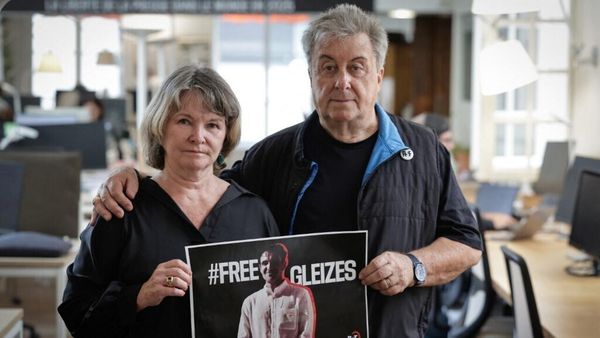
The weighty responsibility of portraying a character with schizophrenia is something Tom Conroy feels keenly. That he is portraying a real person in the Belvoir St Theatre’s current production, Tell Me I’m Here, adapted from Anne Deveson’s bestselling memoir of the same name, only makes it more important that he gets it right.
Conroy plays Deveson’s son, Jonathan Blain, who was diagnosed with schizophrenia as a teenager and eventually died of a drug overdose at the age of 24. Photographs of Blain adorn Conroy’s dressing room mirror.
“I feel a great sense of responsibility to Jonathan and to Anne, and to all the other mothers and sons who are still living through similar experiences that they went through,” Conroy says. “The guiding light each night is the reminder that this performance is much larger than myself. There’s a responsibility from me to be as vulnerable and as open as I can onstage, in order to try and show as much of what he lived through.”

Perhaps no mental illness has been more misrepresented in art than schizophrenia. Hollywood, in particular, has churned out an endless parade of mad and bad characters. But the Belvoir’s production has the rare distinction of being endorsed by Sane Australia, the national mental health advocacy and support organisation co-founded by Deveson in the mid 1980s.
Among the significant body of work that Deveson left upon her death in 2016, perhaps the most famous was her 1991 memoir, Tell Me I’m Here: an excruciating documentation of her son’s frightening psychological decline after being diagnosed with schizophrenia.
Blain’s death from a drug overdose in 1984 led Deveson and Dr Margart Leggatt to form the Schizophrenia Fellowship of NSW the next year, which later became Sane Australia. Alongside providing support for people with complex mental illness and their families, one of the organisation’s missions for the past 25 years has been monitoring the media’s portrayal of mental illness and suicide.
Sane’s current chief executive, Rachel Green, has seen the play twice and sat in on a number of rehearsals. “I think what it does so beautifully is that it shows Jonathan [Blain] and his family coping with the real daily difficulties of living with psychosis,” she says. “You just want to give Jonathan a big hug at the end.”
“My big mission was to make sure that we presented Jonathan as a whole human being. His illness defined the final part of his life, but there was a person who was more than that,” Conroy says. “He had a great sense of humour, a great capacity for love, for reading and for art.”

Blain’s use of art in his quest to make meaning of his illness is conveyed through Conroy’s frenetic drawings that cover most of the stage’s walls and floors by the closure of each night’s performance. Before this production, Conroy had not attempted to draw anything since high school, so he delved into the National Library of Australia’s archives, where Blain’s art is kept.
“It was through his art that Jonathan was able to tell his story of wonder and joy and hope … as well as the terror and fear and darkness that he lived through,” says Conroy.
Conroy first read the memoir a decade ago, as part of his research into playing a characterwith psychosis in another play; it had “a huge impact” on him. For Tell Me I’m Here, he poured over clinical discussions of schizophrenia but soon realised that the key to “getting” Jonathan would be through his experiences. He began consuming blogs, online community forums and podcasts made by people with schizophrenia.
His bible was Out of the Madhouse, the “madhouse” being Melbourne’s Larundel psychiatric hospital. The 2020 book was co-written by Sane co-founder Leggatt and Sandy Jeffs, a writer who lives with schizophrenia and has spent numerous periods of her life in psychiatric institutions.
Conroy and Jeffs talked about her life; just like Blain, Jeffs also experiences auditory hallucinations every day. She was also able to describe the physical effects the antipsychotic drugs of the 1970s and 1980s would have had on Blain, which are shown in some of the play’s most confronting scenes.
“I was really touched by how open and generous she was in terms of talking through what it’s like to have auditory hallucinations and how her delusions have manifested themselves over the years and the impact that has had on her,” Conroy says.
“It really struck me how relentless those voices are – a constant denigrating barrage, doing everything they can to make her feel worthless, small and make her feel like she should end her life. Every day she has to combat this, and decide to live her life with purpose.”
As Deveson wrote, with heart-wrenching honesty, a mother’s love and understanding was not enough to save her child. One of the crucial messages of both the play and the book, is the toll mental illness can take not just on an individual, but their family too.
“What’s incredibly powerful about this play is that it makes you actually care, like if it was your baby who grew up with schizophrenia, or your brother, or your husband,” says Green. “Getting the community to actually care, through a play – that’s a really powerful thing.”
Tell Me I’m Here is on at Belvoir St Theatre, Sydney, until 25 September.
In Australia, support is available at Beyond Blue on 1300 22 4636, Lifeline on 13 11 14, and at MensLine on 1300 789 978. In the UK, the charity Mind is available on 0300 123 3393 and Childline on 0800 1111. In the US, Mental Health America is available on 800-273-8255







